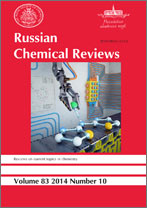|
This article is cited in 59 scientific papers (total in 59 papers)
Addition Reactions with Intramolecular Cyclisation
V. I. Staninets, E. A. Shilov
Institute of Organic Chemistry, Academy of Sciences of the Ukrainian SSR, Kyiv
Abstract:
Heterolytic addition reactions in which the effect of the electrophilic agent on a double or triple bond leads to intramolecular cyclisation via an electron-donating group ("the AC reaction") are discussed. These reactions almost always give rise to five- and six-membered rings. Weak electrophilic agents form only cyclic adducts under the conditions of AC reactions, while strong electrophilic agents form, together with cyclic compounds, simple and mixed acyclic addition products. The formation of cyclic adducts is also promoted by the rigid structure of the unsaturated molecule and the nucleophilic properties of the electron-donating group.
The AC reactions obey the kinetic equations for second-order processes. They are distinguished from the analogous trimolecular acceptor–donor addition reactions by the synchronous occurrence of the electrophilic and nucleophilic stages in the elementary step, which is related to the steric conditions of ring formation.
The bibliography includes 124 references.
Citation:
V. I. Staninets, E. A. Shilov, “Addition Reactions with Intramolecular Cyclisation”, Usp. Khim., 40:3 (1971), 491–512; Russian Chem. Reviews, 40:3 (1971), 272–283
Linking options:
https://www.mathnet.ru/eng/rcr2436https://doi.org/10.1070/RC1971v040n03ABEH001918 https://www.mathnet.ru/eng/rcr/v40/i3/p491
|


| Statistics & downloads: |
| Abstract page: | 136 |
|





 Contact us:
Contact us: Terms of Use
Terms of Use
 Registration to the website
Registration to the website Logotypes
Logotypes










